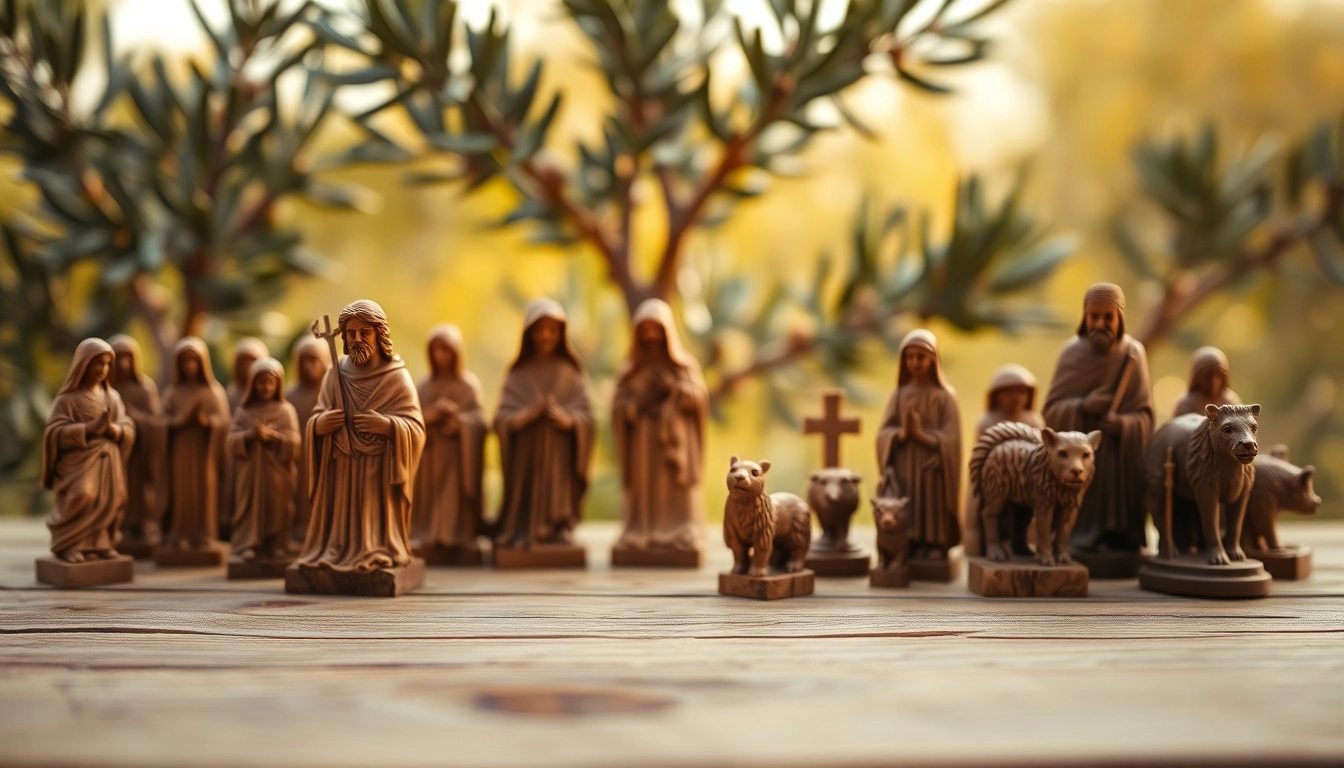
Understanding Olive Wood Carvings
In the realm of craftsmanship, few materials are as revered and symbolism-rich as olive wood. Carved intricately by skilled artisans, olive wood carvings encapsulate not only artistic creativity but also deep cultural heritage. The unique properties of olive wood, its historical significance, and the craftsmanship involved make these pieces not just decorative items but also embodiments of tradition and artistry.
The Significance of Olive Wood in Art
Olive wood holds a special place in both art and culture, particularly in regions like the Middle East where the olive tree is often seen as a symbol of peace and prosperity. The wood itself, known for its rich colors and beautiful grain patterns, enhances the aesthetic appeal of any carving. Beyond aesthetics, olive wood has spiritual connections in various cultures, particularly among Christians, where it is often associated with sacred art and religious practices.
History of Olive Wood Carving Techniques
The tradition of olive wood carving is deeply rooted in history, tracing back centuries in the Holy Land. Originally, this craft was a means of livelihood for local artisans, passed down through generations. Artisans developed unique techniques that turned the hard and dense olive wood into intricate sculptures, olive wood crosses, and functional items. This historical continuity contributes to the objects’ value and significance, showcasing the persistence of cultural practices amidst the changing times.
Common Uses of Olive Wood Carvings
Olive wood carvings serve various purposes, ranging from decorative art pieces to practical items. Common uses include:
- Religious Items: The most popular categories include crosses, nativity scenes, and figurines representing biblical figures.
- Decorative Art: Carvings that enhance home decor, such as wall hangings, sculptures, and unique vases.
- Functional Objects: Many artisans craft items that are both beautiful and functional, including bowls, utensils, and cutting boards.
Craftsmanship Behind Olive Wood Carvings
Creating olive wood carvings is an art that combines creativity, techniques, and a deep understanding of the wood’s properties. The craftsmanship behind these works is what makes each piece unique and imbued with meaning.
Materials and Tools Used in Carving
The primary material, olive wood, is celebrated for its durability and unique aesthetics. Craftsmen often prefer local variants which are sustainably sourced. Key tools used in carving include chisels, knives, and gouges, each serving a specific purpose in the crafting process. From the initial rough shaping to final finishing touches, these tools help the artisan bring the wood to life.
Traditional vs. Modern Carving Techniques
While traditional carving techniques remain dominant, modern influences are ushering in new methods. Traditional methods, often painstaking and time-consuming, emphasize detailed handwork, requiring significant skill and patience. In contrast, modern techniques might incorporate machine assistance for certain processes, which allows for consistent production but often lacks the intimate touch of hand-carved pieces. Each approach has its merits, yet the traditional method retains its allure due to the individual care and craftsmanship involved.
Skills and Training for Carvers
Becoming a skilled olive wood carver is no small feat. Many artisans undergo years of training, often starting as apprentices under experienced masters. The training covers understanding wood characteristics, mastering tools, and developing artistic vision. This mentorship model not only preserves the skills but also imbues a sense of pride in maintaining cultural heritage.
Popular Olive Wood Carving Products
As artisans continue to explore the potential of olive wood, various products have gained popularity worldwide. Each item often tells a story or holds specific religious or cultural significance.
Figurines and Statues: Religious Representations
Among the most cherished olive wood carvings are religious figurines and statues. Carved representations of biblical figures often serve as significant spiritual artifacts in homes and churches alike. These pieces typically capture moments of spirituality or faith, providing believers with tangible connections to their beliefs.
Olive Wood Nativity Sets: Symbolism and Craft
The nativity scene is a cherished component of Christmas traditions worldwide. Olive wood nativity sets are particularly sought after due to their lifelike details and the warmth of the wood. These scenes not only serve as decorations but are also used during holiday celebrations, symbolizing significant moments in Christianity’s narrative.
Unique Gifts and Decorative Pieces
Aside from religious items, olive wood carvings make for unique gifts and decorative pieces. From intricately designed bowls to artistic sculptures, these items often catch the eye and stir up conversation, making them popular choices for gift-giving. Their uniqueness guarantees that each piece stands out in a collection.
Purchasing Olive Wood Carvings
For those interested in acquiring olive wood carvings, understanding the market can enhance the purchasing experience. Numerous factors come into play, including authenticity, quality, and fair pricing.
Where to Buy Authentic Olive Wood Carvings
Authenticity matters when purchasing olive wood carvings. Reliable sources often include local artisans in Bethlehem, Jerusalem, and reputable online stores specializing in religious and decorative art. Look for sellers who provide information about the sourcing of their wood and the artisans behind the crafts.
What to Look for in Quality Carvings
Quality can often be identified by examining several features:
- Detailing: Authentic carvings should possess intricate details, showcasing the skill of the artisan.
- Finishing: A fine finish reflects good craftsmanship; pieces should feel smooth and polished.
- Wood Quality: Look for pieces that display the beautiful grain of olive wood, indicating a quality product.
Understanding Pricing and Value Differences
Pricing can vary widely based on the intricacy of the piece, the reputation of the artist, and the materials used. Generally, handcrafted items are priced higher than machine-produced ones. Buyers should be cautious of deals that seem too good to be true, as they may indicate inferior quality or non-authentic products.
The Impact of Olive Wood Carving on Local Communities
The craft of olive wood carving has far-reaching implications beyond artistic expression. Not only does it provide financial stability for artisans, but it also helps maintain cultural and historical practices.
Supporting Artisans in the Holy Land
Purchasing olive wood carvings aids local artisans, allowing them to sustain their craft and livelihoods. Many artisans in the Holy Land come from families who have been carving wood for generations, and supporting their work contributes to preserving these age-old traditions.
Economic Benefits of Olive Wood Sales
Olive wood carving significantly contributes to the economy of the regions where it is practiced. The export of carved products generates income and supports jobs related to crafting, selling, and promoting the art. This economic boost can be particularly vital in areas facing challenges regarding employment and livelihood.
Promoting Cultural Heritage through Art
Beyond economic factors, the promotion of olive wood carving serves a vital role in preserving cultural heritage. These carvings embody stories, traditions, and beliefs that connect current generations with their past. A successful carving not only speaks to the artistry involved but also serves as a cultural ambassador, sharing the rich heritage of the Holy Land with the world.





